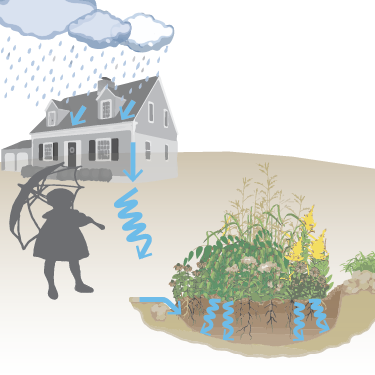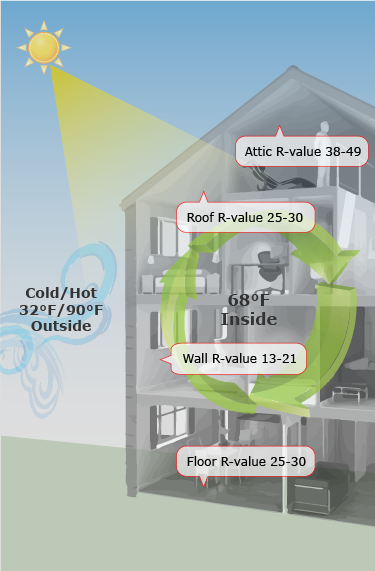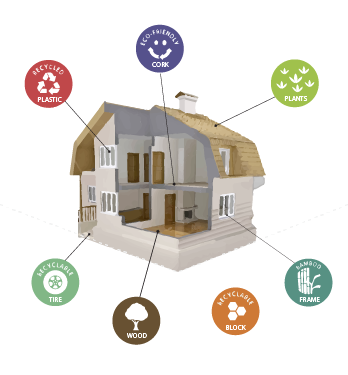
Can a house be green? You may answer, “A green house is the one that is green in color.” While we would have to agree that a house COLORED green IS a “green” house, today when we talk about a house being green, we mean a house whose performance, rather than appearance is green. A house that is green in performance is a house that responds to local climate conditions, uses passive and active measures to reduce energy use, filters water, grows food and takes advantage of its location setting. Houses of all colors can become more ‘green’ by orienting windows to the south for direct sunlight, insulating or creating thick walls (especially to the north) to keep heat in and cold out, optimizing space and using energy efficient appliances and non toxic, renewable materials. Try a series of activities and green your imagination about houses!
Activity 1 – Hydrate (Outside)

Green Homes collect, filter and reuse water. Take a look at rainwater collection to see how a house can collect. Learn about rain gardens and get a plan of your house or a typical house and map areas suitable for raingardens. Using Google Scribble Maps, plot and locate places for rain collecting water barrels, areas for plant absorbing raingardens. Conserve! Collect!
Activity 2 – Hydrate (Inside)

Once you have completed your outdoor water use search, walk inside. Do you have any drippy faucets? If so, they need to be replaced. How about your toilets? How many do you have? Are they low flush or regular? Consider replacing them one by one and saving water. As part of your water system, is your hot water heater constantly heating water for your cup of tea or shower – even when you sleep? If so consider replacing it with an on demand hot water heater that only uses energy to heat water when you need it!
Conserve! Collect!
Activity 3 – Ventilate

Passive and active systems work together to make a house green. Natural ventilation, natural solar heat and light gain, and water collection and reuse contribute to NET ZERO Homes and Passive Homes. Using the 55-degree temperature below the ground is called geothermal support for heating and cooling. They use 55 degrees with a water or heat pump to offset warming or cooling. The earth below the freezing line or desert surface is a steady 55 degrees. Moving air through underground tubes can add a cool 55 degrees toward cooling a house when the outside temperature is 80 and above. Adding a warm 55 degrees to zero or below air can help supplement heating bills. Placing operable windows on opposite sides of a house, downstairs and up, can create natural hot air that rises for ventilation. Adding an attic fan to pull hot air up, upwards, and out will increase air movement and cooling when the air is still. Draw a section of your house and show natural cross-ventilation air movement, solar gain or shading (south side), and the location of geothermal wells for heating and cooling. Be sure to locate an attic fan in a top-floor window! Use natural earth, air, and sunlight systems to support your green home! Complete the Green Home Worksheets to learn about creative energy-saving careers!
Activity 4 – Situate

Like vernacular architecture, green homes respond to location and climate. Whether a house is built under, in, on, or on top of the ground depends on temperature, seasons, soils, humidity and air movement. Higher elevations tend to be dryer and lower elevations tend to collect water. Arid homes need to have thick walls and little windows on opposite sides for cross ventilations to keep shaded, cool, and breezy. Humid and hot homes need to be off the ground to keep dry and have cross ventilation to keep cool. Winter houses with lots of freezing weather and snow need to have south facing windows and north facing trees to protect them from cold winds. Roofs where there is rain and snow need to be sloped; roofs where it is hot and dry can be flat. Using Google Scribble Maps locate your house. Print the aerial view and locate north; mark the sweep of the sun’s path for heat and warmth as a positive or a negative. Depending upon your location, label the climate and site needs of your house. Consider in, on, and above ground location. Note size and orientation of windows. Note type of roof and the weather it is trying to mediate. Get situated!
Activity 5 – Vegetate

Planting deciduous trees on the east and west sides of a building provide light filtering, or shading, in the hot summer. As leaves fall they let in warm winter light. Evergreen trees planted in rows on the side of houses where winter wind blows help to protect entrances. Planting shrubs and perennial plants provide deep roots for absorbing water and diminishing water runoff. Plants, shrubs, and trees provide shade and cool areas as well as help to moisten and clean the air. Vegetable gardens and orchards can help supply homeowners with needed food. Make another copy of your house and note where you have trees, plants and shrubs planted.
Activity 6 – Insulate

A green home is insulated against cold and hot climates. It has insulation, or thermal material, in its roof, walls, floors and attics. The insulation protects the inside from the outside temperature difference. The colder the climate the higher R value (or thermal resistance) that is needed. Insulation provides an R value for roofs, walls, floors and attics. Whether it is fiberglass batt insulation or spray foam insulation, it traps tiny air pockets that slow the transfer of temperature. Foam board insulation thickens the mass of material slowing temperature movement. High performance windows, or windows that have two or three sealed layers (called double or triple glazed) lose less heat than single pane windows and provide R values of 1-12.5. In cold weather, window blankets help to keep cold temperatures from transmitting.
Check out R Value Calculators for recommendations for your house- Insulation Calculator or Insulate Fact Sheet by ZipCode. Take pictures of the insulation installed in your own home to see where thermal resistance is being employed. On a picture of your house, label the R value it needs in the roof, walls, floors and basement.
Activity 7 – Optimize

Space in green homes optimizes interior space so that the building size is conservative and efficient. The more compact the footprint of a building, the more energy efficient the building will be. The more land the building covers, the longer the distance energy, air, and water must travel. The larger the home, the more cubic footage must be heated and/or cooled.
Activity 8 – Materialize

After a green home is built, occupying it with reused, recycled, and renewable materials is important. Embodied energy means the total amount of energy used to extract, transport, produce, install and maintain a material over its life. This embodied energy concerns the lifecycle of the material as well. Green materials are materials that do not off gas VOCs nor have high amounts of embodied energies. VOC stands for volatile organic compounds which off gas from materials with chemicals and polymers (or plastic). VOCs contribute to poor and often dangerous indoor air quality. Materials found in nature do not off gas. Green materials are also materials that can be replenished and/or reused. Take an inventory of the green materials in your home and the materials that are nonrenewable and toxic. How does your house fare?
Activity 9 – Activate

Green homes activate and use passive systems first, then active systems second. Passive systems are those air, water, energy cycles provided by location and climate. Active systems are those connected to technology. As things are placed in the home, see how many require and use energy. Take an energy audit and see if heating/cooling/lighting or appliances use the most energy. Find ways to conserve energy use. Take a look at the Black Balloon movie to see where to look for energy usage in your home. Consider energy efficient appliances that use less energy. Check out appliances at EnergyStar. Make a list of energy saving activities you can do to save energy in your house.
Review
- What is a green house? A house painted green
- What is the purpose of a rain garden in a green home?
- Which of the following is a recommended way to conserve water inside a green home?
- What is the most suitable roof type for a house located in a region with heavy snowfall?
- Why are deciduous trees beneficial when planted on the east and west sides of a house in northern hemispheres?
- Why are deciduous trees beneficial when planted on the east and west sides of a house?
Explore
- 3d Printed Mid Century Ranch House
- BEECO GREEN Home
- California Energy Smart House
- EIE Insulated Home Kit
- Energy3D
- EPA Do it Yourself Insulation & Caulking Guide
- EWG Healthy Caulks and Sealants
- EWG Healthy Home
- Forest House Envelope Architects
- Guide to Green Materials
- Guide to Upkeep of New Home
- Home Energy Yard Stick
- Interactive Carbon Footprint for Homes via zipcode
- Living Building Challenge
- Mitsubishi Timeline of Passive House
- Passive House
- Passive House Institute
- R16 Windows by VacuMAX
- Recycling at Home
- Solar Decathalon Homes 2013
- TUCKS Tips for Greening Your Bedroom
- USGBC Green Home Building Guide
- VacuMAx Vidrio Aislante al Vacio
- Video Passive House in 90 seconds!
- Video TECHstyle House w/Photovoltaic Fabric Skin
Relate
- Architecture
- Biomes
- Building Skins
- Buildings like Bodies
- Climate
- Design Process
- Design Thinking
- Electricity
- Energy
- Green Building
- Green Cities
- Green Dollhouse
- Green Materials
- Green Roofs
- Green Schools
- Growing food
- House of the Future
- Landscape
- Nature Play
- Neighborhood
- Rain Gardens
- Rain Water Harvesting
- ReBUILD
- River Walks
- School Gardens
- Shelter
- Site Analysis
- Site Programming
- Smart Grid
- Solar Energy
- Space Planning
- Sunlight
- TIny House
- Vegetable gardens
- Vernacular Architecture
- Water Conservation
- Water Quality
- Watershed
- Weather
- Windows
- Wind Power
- Zero Net Homes



















































